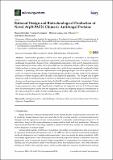Por favor, use este identificador para citar o enlazar a este item:
http://hdl.handle.net/10261/173576COMPARTIR / EXPORTAR:
 SHARE SHARE
 CORE
BASE CORE
BASE
|
|
| Visualizar otros formatos: MARC | Dublin Core | RDF | ORE | MODS | METS | DIDL | DATACITE | |

| Título: | Rational design and biotechnological production of novel AfpB-PAF26 chimeric antifungal proteins |
Autor: | Heredero, Marcos; Garrigues, Sandra CSIC ORCID; Gandía Gómez, Mónica CSIC ORCID; Marcos López, José Francisco CSIC ORCID ; Manzanares, Paloma CSIC ORCID | Palabras clave: | Antifungal proteins Rational design Chimeric proteins Cysteine-rich proteins Penicillium digitatum FungalBraid |
Fecha de publicación: | 15-oct-2018 | Editor: | Multidisciplinary Digital Publishing Institute | Citación: | Microorganisms 6(4): 106 (2018) | Resumen: | Antimicrobial peptides (AMPs) have been proposed as candidates to develop new antimicrobial compounds for medicine, agriculture, and food preservation. PAF26 is a synthetic antifungal hexapeptide obtained from combinatorial approaches with potent fungicidal activity against filamentous fungi. Other interesting AMPs are the antifungal proteins (AFPs) of fungal origin, which are basic cysteine-rich and small proteins that can be biotechnologically produced in high amounts. A promising AFP is the AfpB identified in the phytopathogen Penicillium digitatum. In this work, we aimed to rationally design, biotechnologically produce and test AfpB::PAF26 chimeric proteins to obtain designed AFPs (dAfpBs) with improved properties. The dAfpB6 and dAfpB9 chimeras could be produced using P. digitatum as biofactory and a previously described <i>Penicillium chrysogenum-based expression cassette, but only dAfpB9 could be purified and characterized. Protein dAfpB9 showed subtle and fungus-dependent differences of fungistatic activity against filamentous fungi compared to native AfpB. Significantly, dAfpB9 lost the fungicidal activity of PAF26 and AfpB, thus disconnecting this activity from the fungistatic activity and mapping fungicidal determinants to the exposed loop L3 of AfpB, wherein modifications are located. This study provides information on the design and development of novel chimeric AFPs. | Versión del editor: | https://doi.org/10.3390/microorganisms6040106 | URI: | http://hdl.handle.net/10261/173576 | DOI: | 10.3390/microorganisms6040106 | E-ISSN: | 2076-2607 |
| Aparece en las colecciones: | (IATA) Artículos |
Ficheros en este ítem:
| Fichero | Descripción | Tamaño | Formato | |
|---|---|---|---|---|
| rational_proteins_2018.pdf | 3,28 MB | Adobe PDF |  Visualizar/Abrir |
CORE Recommender
PubMed Central
Citations
6
checked on 11-abr-2024
SCOPUSTM
Citations
8
checked on 15-abr-2024
WEB OF SCIENCETM
Citations
7
checked on 22-feb-2024
Page view(s)
267
checked on 16-abr-2024
Download(s)
221
checked on 16-abr-2024

